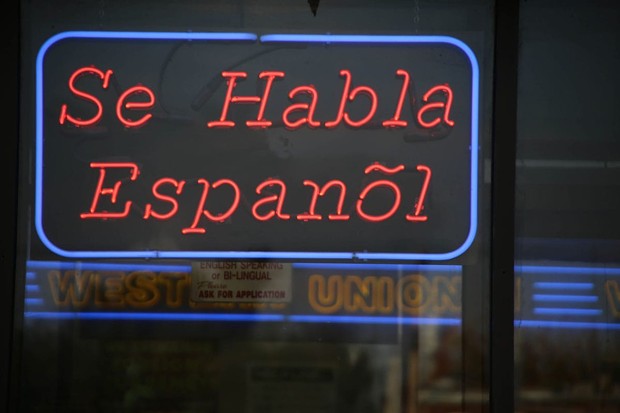[
{
"name": "Top Stories Video Pair",
"insertPoint": "7",
"component": "17087298",
"parentWrapperClass": "fdn-ads-inline-content-block",
"requiredCountToDisplay": "1"
}
]
One of my first memories interacting with other children in our community is of having my older brother, Mauro, interpret for me as we were playing — he was attending school and picking up English much faster than I was. We would migrate back and forth from Mexico where my abuelita y abuelo (grandma and grandfather) lived and, for the most part, I could get along speaking only Spanish. However, by the time of this memory we had pretty much settled on living in the greater Los Angeles area.
My parents had managed to purchase a two-lot property in a neighborhood that was at the threshold of transition. My father, who had grown up on a ranch, quickly filled our seemingly huge backyard with a goat, chickens, ducks, rows of maíz (corn), tomatoes, chiles (chile peppers) and nopales (edible cactus). He planted an avocado tree, a lemon tree and a peach tree, as well as various herbs. Our neighbors were not accustomed to having a “farm” in the middle of their neighborhood. Nevertheless, despite my parents limited English, we managed to quell issues and become valued members of our community by getting rid of our rooster and sharing the cosecha (harvest) with neighbors within earshot of cackling chickens, a bleating goat and quacking ducks. Via a mixture of whole-body gesticulations, broken English and varied facial expressions, we interacted and cooperated with our neighbors in ways that were mutually beneficial.
The communication barrier that existed for my siblings, my parents, other community members and me was one of the most outstanding and impactful elements of our daily lives. Along with the aforementioned set of non-verbal cues, daily interactions rely heavily on our ability to understand and to be understood via what are sometimes called the four domains of language (listening, speaking, reading and writing). My mother, a homemaker/factory worker and my father, a mechanic were able to understand, speak and read English at a very basic level — just enough to get along with at work and in daily life.
As we settled into the neighborhood and it slowly transitioned from a mostly English-speaking community to one in which Spanish became the common language, especially for the adults, I learned to communicate in both English and Spanish. I quickly became the mediator or transporter of messages from the English-speaking community to my parents, as well as my parents’ voice when they needed to express themselves to English-only speaking members of our larger community. I became the default interpreter for my parents at school, as well as at other venues in which language was a barrier.
I recall the first time I came home from school seeking help with my homework. Although my parents understood the importance of an education — in fact that was one of the principle reasons for immigrating to the U.S. — they responded with, “No puedo entenderlo” (I don’t understand it). I realized that I had to find other ways to improve my academic skills or I would struggle with my learning; unfortunately, this did occur, but that is another story.
Humboldt County has a population of more than 7,000 residents for whom English is not a primary language. Our schools are composed of approximately 16,000 students and more than 2,000 of these students come from homes in which a language other than English is the main vehicle of communication. These families struggle to seek information, understand systems and support their children’s learning; this is exacerbated by the omnipresent distance that is currently permeating our daily activities.
Thirteen years ago, after having visited the region on a camping trip a few years prior, my wife and I moved to Arcata with her cat Zorro, and my father Mauro. We enjoyed the cool climate and friendly people and, although we were very content in our previous professional posts — she as a special education teacher and I as a language-immersion teacher — we made the decision to move here and begin a family. Once a post presented itself — part-time fifth grade Spanish teacher for math and science at a nascent Spanish immersion school — I called and negotiated a full-time position. After a long interview process in which the school’s director came to my classroom in Long Beach to observe, I was hired as the program coordinator, visual arts instructor and Spanish math and science teacher. It was fascinating to find myself in a place to teacher children how to “transport their messages” into Spanish by learning this as a second language.
During this moment of abrupt change to many things, including learning and teaching, our students and educators are all novelly challenged and our approach is shifting at a quickened rate. During this pandemic, (from pan “all” and dēmos “people”) issues of equity are magnified — access to the basics like food, technology and how schools communicate with parents to support our children's development. Throughout Humboldt, our schools, administrators and teachers are innovating to meet the needs of children and families. The work that is happening is incredible and it is a collective of “all people” in our community helping at many levels. When you find a need to communicate orally or in a written form with someone who has not yet mastered English, please reach out to an interpreter (oral) or translator (written) to ensure your message is conveyed and that you are able to hear the concerns, questions and comments of others in our collective community.
Here are some resources for interpretation (spoken), and translation (written) services:
Local Translation and Interpretation Services:
• Contact me at [email protected] (Humboldt County Office of Education Interpretation/Translation Services), world languages and cultures translation and interpretation courses. (Students may be able to support limited translation and interpretation needs depending on multiple factors — please contact World Languages and Cultures.)
• Northcoast Translate
• HSU’s Spanish Translation and Interpretation Club, Behavioral and Social Sciences Building, Room BSS 206. 826.3226. [email protected] or me at [email protected]. (Current instructor for interpretation and translation courses.)
Interpretation Equipment:
• Humboldt Area Foundation, 363 Indianola Road, Bayside, CA 95524. 442-2993. Monday through Friday 8:30 a.m. to 5 p.m. (Call to reserve equipment. Two sets are available-each approximately 50 headsets.)
• Community Wellness Center 908 Seventh St., Eureka. 268-2132. (Call to reserve equipment. Two sets are available one small and one medium.)
Agustín Amaro is a credentialed educator and administrator and prefers he/him pronouns. He is a learning specialist for language learner programs for the Humboldt County Office of Education.
My parents had managed to purchase a two-lot property in a neighborhood that was at the threshold of transition. My father, who had grown up on a ranch, quickly filled our seemingly huge backyard with a goat, chickens, ducks, rows of maíz (corn), tomatoes, chiles (chile peppers) and nopales (edible cactus). He planted an avocado tree, a lemon tree and a peach tree, as well as various herbs. Our neighbors were not accustomed to having a “farm” in the middle of their neighborhood. Nevertheless, despite my parents limited English, we managed to quell issues and become valued members of our community by getting rid of our rooster and sharing the cosecha (harvest) with neighbors within earshot of cackling chickens, a bleating goat and quacking ducks. Via a mixture of whole-body gesticulations, broken English and varied facial expressions, we interacted and cooperated with our neighbors in ways that were mutually beneficial.
The communication barrier that existed for my siblings, my parents, other community members and me was one of the most outstanding and impactful elements of our daily lives. Along with the aforementioned set of non-verbal cues, daily interactions rely heavily on our ability to understand and to be understood via what are sometimes called the four domains of language (listening, speaking, reading and writing). My mother, a homemaker/factory worker and my father, a mechanic were able to understand, speak and read English at a very basic level — just enough to get along with at work and in daily life.
As we settled into the neighborhood and it slowly transitioned from a mostly English-speaking community to one in which Spanish became the common language, especially for the adults, I learned to communicate in both English and Spanish. I quickly became the mediator or transporter of messages from the English-speaking community to my parents, as well as my parents’ voice when they needed to express themselves to English-only speaking members of our larger community. I became the default interpreter for my parents at school, as well as at other venues in which language was a barrier.
I recall the first time I came home from school seeking help with my homework. Although my parents understood the importance of an education — in fact that was one of the principle reasons for immigrating to the U.S. — they responded with, “No puedo entenderlo” (I don’t understand it). I realized that I had to find other ways to improve my academic skills or I would struggle with my learning; unfortunately, this did occur, but that is another story.
Humboldt County has a population of more than 7,000 residents for whom English is not a primary language. Our schools are composed of approximately 16,000 students and more than 2,000 of these students come from homes in which a language other than English is the main vehicle of communication. These families struggle to seek information, understand systems and support their children’s learning; this is exacerbated by the omnipresent distance that is currently permeating our daily activities.
Thirteen years ago, after having visited the region on a camping trip a few years prior, my wife and I moved to Arcata with her cat Zorro, and my father Mauro. We enjoyed the cool climate and friendly people and, although we were very content in our previous professional posts — she as a special education teacher and I as a language-immersion teacher — we made the decision to move here and begin a family. Once a post presented itself — part-time fifth grade Spanish teacher for math and science at a nascent Spanish immersion school — I called and negotiated a full-time position. After a long interview process in which the school’s director came to my classroom in Long Beach to observe, I was hired as the program coordinator, visual arts instructor and Spanish math and science teacher. It was fascinating to find myself in a place to teacher children how to “transport their messages” into Spanish by learning this as a second language.
During this moment of abrupt change to many things, including learning and teaching, our students and educators are all novelly challenged and our approach is shifting at a quickened rate. During this pandemic, (from pan “all” and dēmos “people”) issues of equity are magnified — access to the basics like food, technology and how schools communicate with parents to support our children's development. Throughout Humboldt, our schools, administrators and teachers are innovating to meet the needs of children and families. The work that is happening is incredible and it is a collective of “all people” in our community helping at many levels. When you find a need to communicate orally or in a written form with someone who has not yet mastered English, please reach out to an interpreter (oral) or translator (written) to ensure your message is conveyed and that you are able to hear the concerns, questions and comments of others in our collective community.
Here are some resources for interpretation (spoken), and translation (written) services:
Local Translation and Interpretation Services:
• Contact me at [email protected] (Humboldt County Office of Education Interpretation/Translation Services), world languages and cultures translation and interpretation courses. (Students may be able to support limited translation and interpretation needs depending on multiple factors — please contact World Languages and Cultures.)
• Northcoast Translate
• HSU’s Spanish Translation and Interpretation Club, Behavioral and Social Sciences Building, Room BSS 206. 826.3226. [email protected] or me at [email protected]. (Current instructor for interpretation and translation courses.)
Interpretation Equipment:
• Humboldt Area Foundation, 363 Indianola Road, Bayside, CA 95524. 442-2993. Monday through Friday 8:30 a.m. to 5 p.m. (Call to reserve equipment. Two sets are available-each approximately 50 headsets.)
• Community Wellness Center 908 Seventh St., Eureka. 268-2132. (Call to reserve equipment. Two sets are available one small and one medium.)
Agustín Amaro is a credentialed educator and administrator and prefers he/him pronouns. He is a learning specialist for language learner programs for the Humboldt County Office of Education.
Speaking of...
Latest in Views
Readers also liked…
-
Hope
- Sep 7, 2023
-
California Says No to Privatizing Medicare
- Sep 21, 2023



































